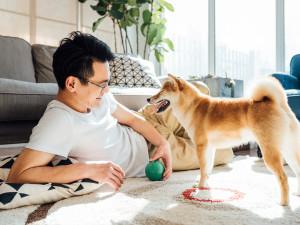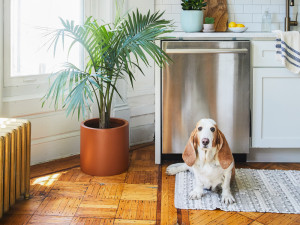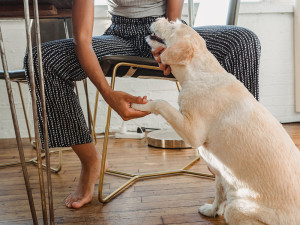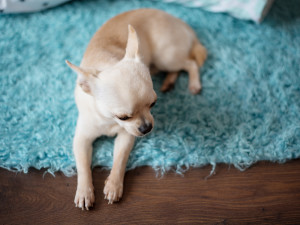Let’s Talk Eco-Friendly Flooring Options for Pets
Wise choices make your home healthier for you and your pet
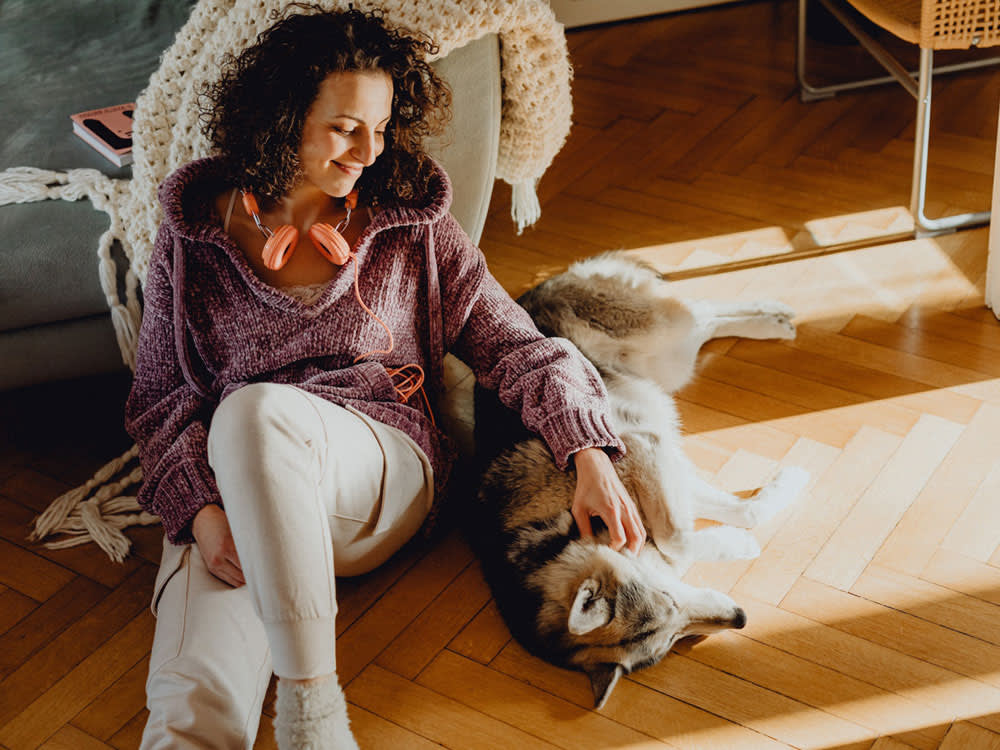
Share Article
Try this: select a spot in your home and lie down on the floor. Is it the kitchen? Give the floor a little lick. Or the living room? Put your nose on the carpet and take a really deep breath. Then, wander into the bathroom and check out the porcelain ‘drinking fountain’. OK, stop the experiment. You get the idea: this is your home from your dog’s point of view. You generally experience your surroundings from a five- or six-foot elevation, but your pet is much closer, and much more inclined to sample their surroundings.
What is pet-friendly flooring?
While there isn’t one set definition for ‘green’ or ‘eco’ buildings, there are important general concepts to bear in mind: energy efficiency, size (it matters), sustainability, use of recycled materials and low impact. But, the other benefit of eco-friendly materials is the impact it has on health, considering that one in four dogs will develop cancer. Pet-friendly flooring should also be somewhat scratch-resistant and water-resistant.
If you’re renovating or redecorating, use resource-smart building materials, which are safer for you and your pet as well as for the environment. And, before you purchase flooring material, or even paint for your walls, give some thought to the environmental consequences of your choices. Even small changes can have a big impact. Consider using traditional materials – beeswax polish and vinegar and lemon juice for cleaning, for example – zero to low-VOC paint (latex), finishes and adhesives; and non-aerosol products.
Follow suggestions laid out by green-building expert Jennifer Roberts in her book, Good Green Homes. When you’re selecting home furnishings or building materials, ask yourself (or the retailer or product manufacturer) the following questions:
Is it safe and healthy to use in my home?
Will it introduce irritants or give off potentially harmful chemicals?
Will I need to use harsh chemicals to clean or maintain it?
Is the harvesting or manufacturing process safe and healthy for workers?
Is there a safe way to reuse, recycle or dispose of it when I’m done with it?
It’s relatively easy being green these days, and a little research will lead you to many good, environmentally sound alternatives. Your cat or dog’s life, not to mention your own, will be better for it. So, let’s redefine what pet-friendly means in terms of flooring, and put health first – pet-friendly should be pet-safe. Many kinds of flooring materials should be considered.
Pet-friendly flooring materials
Wood
There are basically two types of wood: softwoods, which come from rapidly growing trees like pine and fir, and hardwoods, such as oak, maple and teak. Be sure all wood is FSC certified and does not come from old-growth trees. Even better, use reclaimed/recycled wood. Wood flooring is easy to clean with simple products like vinegar and water. Only use zero- to low-VOC and plant-based sealants.
Bamboo
There are more than a thousand different species of this fast-growing woody grass. It is stronger than most hardwoods, and, like wood, can be sanded and refinished multiple times. (Luckily, the type used for flooring is not the kind pandas feed on.) After harvesting, it quickly regenerates. Even if it comes factory-finished, experts recommend resealing it to protect it from doggy water bowl spills.
Linoleum
Made from linseed oil, a byproduct of flax, lino is antibacterial, making it ideal in kitchens and bathrooms. It is also antistatic, so it repels dust and dirt. It comes in a wide range of colours, and even though it does off-gas due to the oxidation of linoleic acid, it is less harmful than vinyl, and considered to be more environmentally friendly.
Cork
From the outer bark of the cork oak tree, cork bark naturally sheds and regrows about once a decade, so harvesting does not harm the tree. Cork resists rot and mould, and makes a great sound-absorber and insulator. It also adds an extra cushioning and bounce to the step, great for the long-standing chef and indoor ball-tossing.
Other good pet-friendly flooring materials to consider are concrete, brick, tile (ceramic, porcelain and glass), terrazzo and stone. Senior dogs need special care and should be provided with soft surfaces and slip-resistant flooring to ease their walking.
But what about vinyl?
Even though its low cost and wide variety of colours and patterns make vinyl a popular flooring choice, polyvinyl chloride (PVC) continues to be the subject of considerable controversy. Its production releases an extraordinarily toxic chemical – dioxin – and many consider PVC to be one of the “most environmentally hazardous consumer materials produced”.
Does pet-safe material cost more?
It doesn’t have to. Many green and pet-safe building features and products cost the same as, or even less than, their conventional counterparts. Other green features may cost more upfront but result in savings year after year. Energy-efficiency upgrades, for example, usually pay for themselves by lowering your monthly energy bill.
How do you clean pet-friendly floors?
Vinegar, one of the oldest (and least expensive) cleaning substances available, is perfect for pet-safe cleaning. A simple floor cleaning solution is a 250ml of vinegar to one litre of water. White vinegar is recommended for cleaning.
Understanding building terms
FSC Certified
The Forest Stewardship Council is an international organisation whose certification process provides consumers with assurance that wood was harvested from well-managed forests and plantations. Be sure to look for the FSC label when purchasing wood. fscus.orgopens in new tab
Off-gas
The release of vapours from a material; many materials in the home off-gas formaldehyde and volatile organic compounds (VOCs). Tip: because interior plywood emits urea formaldehyde (a carcinogen), use exterior-grade plywood instead.
Rapidly renewable resources
Don’t contribute to deforestation; instead, use products made from rapidly renewable resources that regenerate quicker than the demand for the products – bamboo and cork for example.
VOCs
Volatile organic compounds are a range of chemical substances that become airborne, or volatile, at room temperature. They are found in paint, wood preservatives, aerosol sprays, glues, cleansers and disinfectants, moth repellents, dry-cleaned clothing and even air fresheners. VOCs are a major source of indoor air pollution, and exposure can cause symptoms including nausea, eye irritation and headaches. Just think of how your dog will feel being that much nearer to the source. Tip: by choosing a zero to low-VOC water-based paint, you can really reduce, or even eliminate, this concern.
Safer paint
Here’s a quick chemistry lesson. Not everything with ‘organic’ in its name is actually good for us. When we walk into a newly painted room, the first thing we notice – besides the lovely colour – is the smell, which comes largely from VOCs, chemicals added to paint to speed up drying time. Choose low- or zero-VOC paints; interior flat paint with VOC level of 50 grams per litre or less, and interior non-flat paint with 150 grams per litre or less. VOC content should be labelled on the packaging. Note that low odour does not mean low VOC; some manufacturers use fragrance to mask the paint odour.

Claudia Kawczynska
Claudia Kawczynska was co-founder and editor-in-chief of The Bark for 20 years. She also edited the best-selling anthology Dog Is My Co-Pilot.
Related articles
![Man laying on floor playing with dog]()
How to Puppy-Proof Your Home
Is your home a danger-zone for a new dog? Follow these pro tips
![A woman sitting in a chair holding a dogs paw in her hand and holding the dogs face in the other hand.]()
5 Natural Paw Balms That Will Keep Your Pup Safe From Summer Heat
The best paw balms, based on vets’ recommendations
![woman and dog both wearing crocs]()
Who Doesn't Have a Pair of Crocs? Get Your Dog Some Too
Wagwear’s WagWellies Mojave booties let your pup get in on the comfy lifestyle
![Tan Chihuahua dog laying on aqua rug looking down shamefully]()
Why Is My Adult Dog Weeing In the House?
How to re-housetrain a dog of any age

